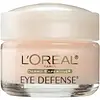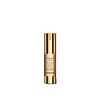What's inside
What's inside
 Key Ingredients
Key Ingredients

 Benefits
Benefits

 Concerns
Concerns

 Ingredients Side-by-side
Ingredients Side-by-side

Water
Skin ConditioningGlycerin
HumectantSimmondsia Chinensis Seed Oil
EmollientPropanediol
SolventPentaerythrityl Tetraethylhexanoate
EmollientPolyglyceryl-2 Stearate
EmulsifyingPhenoxyethanol
PreservativeCarbomer
Emulsion StabilisingCaffeine
Skin ConditioningMyristyl Alcohol
EmollientBisabolol
MaskingMethylparaben
PreservativeSodium Hydroxide
BufferingXanthan Gum
EmulsifyingMica
Cosmetic ColorantEthylparaben
PreservativeDisodium EDTA
Avena Sativa Kernel Extract
AbrasiveCitric Acid
BufferingCI 77891
Cosmetic ColorantFarnesol
PerfumingSodium Hyaluronate
HumectantCI 16035
Cosmetic ColorantWater, Glycerin, Simmondsia Chinensis Seed Oil, Propanediol, Pentaerythrityl Tetraethylhexanoate, Polyglyceryl-2 Stearate, Phenoxyethanol, Carbomer, Caffeine, Myristyl Alcohol, Bisabolol, Methylparaben, Sodium Hydroxide, Xanthan Gum, Mica, Ethylparaben, Disodium EDTA, Avena Sativa Kernel Extract, Citric Acid, CI 77891, Farnesol, Sodium Hyaluronate, CI 16035
Water
Skin ConditioningGlycerin
HumectantButylene Glycol
HumectantPrunus Domestica Seed Extract
EmollientButyrospermum Parkii Butter
Skin ConditioningPropylheptyl Caprylate
EmollientSodium Acrylates Copolymer
Caprylyl Methicone
Skin ConditioningGlyceryl Stearate Citrate
EmollientPvp
Emulsion StabilisingCaffeine
Skin ConditioningBisabolol
MaskingSaccharomyces Cerevisiae Extract
Skin ConditioningAvena Sativa Kernel Extract
AbrasiveHydrolyzed Soy Protein
HumectantSalix Alba Leaf Extract
Skin ConditioningAdenosine
Skin ConditioningPhysalis Alkekengi Calyx Extract
Skin ConditioningEuterpe Oleracea Fruit Extract
Padina Pavonica Thallus Extract
Skin ConditioningHydrolyzed Triticum Monococcum Seed Extract
Skin ConditioningOryza Sativa Extract
AbsorbentSimmondsia Chinensis Seed Oil
EmollientHydrogenated Polyisobutene
EmollientSodium Acryloyldimethyltaurate/Vp Crosspolymer
Emulsion StabilisingPhospholipids
Skin ConditioningPolyglyceryl-10 Stearate
Skin ConditioningHelianthus Annuus Seed Oil
EmollientDisodium EDTA
Pentylene Glycol
Skin ConditioningPPG-26-Buteth-26
Skin ConditioningXanthan Gum
EmulsifyingPEG-40 Hydrogenated Castor Oil
EmulsifyingSodium Hydroxide
BufferingEthylhexylglycerin
Skin ConditioningCitric Acid
BufferingPhenoxyethanol
PreservativeSorbic Acid
PreservativeSodium Benzoate
MaskingPotassium Sorbate
PreservativeTocopherol
AntioxidantWater, Glycerin, Butylene Glycol, Prunus Domestica Seed Extract, Butyrospermum Parkii Butter, Propylheptyl Caprylate, Sodium Acrylates Copolymer, Caprylyl Methicone, Glyceryl Stearate Citrate, Pvp, Caffeine, Bisabolol, Saccharomyces Cerevisiae Extract, Avena Sativa Kernel Extract, Hydrolyzed Soy Protein, Salix Alba Leaf Extract, Adenosine, Physalis Alkekengi Calyx Extract, Euterpe Oleracea Fruit Extract, Padina Pavonica Thallus Extract, Hydrolyzed Triticum Monococcum Seed Extract, Oryza Sativa Extract, Simmondsia Chinensis Seed Oil, Hydrogenated Polyisobutene, Sodium Acryloyldimethyltaurate/Vp Crosspolymer, Phospholipids, Polyglyceryl-10 Stearate, Helianthus Annuus Seed Oil, Disodium EDTA, Pentylene Glycol, PPG-26-Buteth-26, Xanthan Gum, PEG-40 Hydrogenated Castor Oil, Sodium Hydroxide, Ethylhexylglycerin, Citric Acid, Phenoxyethanol, Sorbic Acid, Sodium Benzoate, Potassium Sorbate, Tocopherol
Ingredients Explained
These ingredients are found in both products.
Ingredients higher up in an ingredient list are typically present in a larger amount.
Avena Sativa Kernel Extract is is derived from colloidal oatmeal. Besides being a healthy breakfast, oats have many benefits in skincare too.
This ingredient helps sooth, hydrate, and protect the skin. The starches in colloidal oatmeal are able to bind water, keeping the skin hydrated.
The cellulose and fiber in colloidal oatmeal help reduce inflammation. This can also help the skin feel softer.
Colloidal Oatmeal is also an antioxidant. Antioxidants protect our skin from free-radical damage.
Oatmeal also contains beneficial compounds:
This ingredient is created by mixing grounded oatmeal and a liquid base.
Learn more about Avena Sativa Kernel ExtractBisabolol is famous for its skin soothing properties. It does this by blocking inflammatory signals, helping to reduce your body's reaction to irritation.
This ingredient also interferes with the process of hyperpigmentation. This can help with reducing dark spots and uneven tone.
Bisabolol is an antioxidant. Antioxidants help fight free-radicals. Free-radicals are molecules that may damage your skin cells. By fighting these free-radicals, Bisabolol may slow down signs of aging.
Studies have shown Bisabolol to have antimicrobial properties and may be a fungicide. These properties help preserve a product's shelf life.
All these properties makes bisabolol a great skin barrier helper ingredient.
Bisabolol also helps the absorption of other ingredients.
Note: Synthetic Bisabolol has been shown to be less effective.
Learn more about BisabololCaffeine is most associated with coffee, tea, and cacao. In skincare, it helps with calming inflammation and is rich in antioxidants.
While caffeine is used to treat cellulite and and dark circles, further studies are needed to prove this. It has been believed to help with these skin conditions due to its ability to dilate blood vessels and increase blood flow.
Some studies are looking into caffeine's ability to protect against UV rays.
Learn more about CaffeineCitric Acid is an alpha hydroxy acid (AHA) naturally found in citrus fruits like oranges, lemons, and limes.
Like other AHAs, citric acid can exfoliate skin by breaking down the bonds that hold dead skin cells together. This helps reveal smoother and brighter skin underneath.
However, this exfoliating effect only happens at high concentrations (20%) which can be hard to find in cosmetic products.
Due to this, citric acid is usually included in small amounts as a pH adjuster. This helps keep products slightly more acidic and compatible with skin's natural pH.
In skincare formulas, citric acid can:
While it can provide some skin benefits, research shows lactic acid and glycolic acid are generally more effective and less irritating exfoliants.
Most citric acid used in skincare today is made by fermenting sugars (usually from molasses). This synthetic version is identical to the natural citrus form but easier to stabilize and use in formulations.
Read more about some other popular AHA's here:
Learn more about Citric AcidDisodium EDTA plays a role in making products more stable by aiding other preservatives.
It is a chelating agent, meaning it neutralizes metal ions that may be found in a product.
Disodium EDTA is a salt of edetic acid and is found to be safe in cosmetic ingredients.
Learn more about Disodium EDTAGlycerin is already naturally found in your skin. It helps moisturize and protect your skin.
A study from 2016 found glycerin to be more effective as a humectant than AHAs and hyaluronic acid.
As a humectant, it helps the skin stay hydrated by pulling moisture to your skin. The low molecular weight of glycerin allows it to pull moisture into the deeper layers of your skin.
Hydrated skin improves your skin barrier; Your skin barrier helps protect against irritants and bacteria.
Glycerin has also been found to have antimicrobial and antiviral properties. Due to these properties, glycerin is often used in wound and burn treatments.
In cosmetics, glycerin is usually derived from plants such as soybean or palm. However, it can also be sourced from animals, such as tallow or animal fat.
This ingredient is organic, colorless, odorless, and non-toxic.
Glycerin is the name for this ingredient in American English. British English uses Glycerol/Glycerine.
Learn more about GlycerinPhenoxyethanol is a preservative that has germicide, antimicrobial, and aromatic properties. Studies show that phenoxyethanol can prevent microbial growth. By itself, it has a scent that is similar to that of a rose.
It's often used in formulations along with Caprylyl Glycol to preserve the shelf life of products.
This oil comes from the seeds of the desert shrub called Jojoba. It is more commonly known as jojoba oil, a non-comedogenic oil.
Jojoba oil does not contain fragrance and has many fatty-acids, making it a great soothing ingredient.
It also contains Vitamin E, a great moisturizing ingredient. Vitamin E is also an antioxidant and protects your skin against oxidative damage.
This ingredient humectant properties, meaning it helps draw moisture from the air. This helps keep your skin hydrated.
While jojoba has antibacterial properties, it is only able to kill some strains of bacteria.
Studies also show it helps in wound healing. In fact, Indigenous cultures have used jojoba as a moisturizer and to help treat burns for centuries.
Fun fact: Jojoba oil similar to natural human skin sebum, so it has a great effect on dry skin. It is also promising with helping to regulate sebum production.
Due to its fatty acid content, Jojoba oil may not be fungal acne safe. We recommend speaking with a professional if you have any concerns.
Learn more about Simmondsia Chinensis Seed OilSodium Hydroxide is also known as lye or caustic soda. It is used to adjust the pH of products; many ingredients require a specific pH to be effective.
In small amounts, sodium hydroxide is considered safe to use. However, large amounts may cause chemical burns due to its high alkaline.
Your skin has a natural pH and acid mantle. This acid mantle helps prevent harmful bacteria from breaking through. The acid mantle also helps keep your skin hydrated.
"Alkaline" refers to a high pH level. A low pH level would be considered acidic.
Learn more about Sodium HydroxideWater. It's the most common cosmetic ingredient of all. You'll usually see it at the top of ingredient lists, meaning that it makes up the largest part of the product.
So why is it so popular? Water most often acts as a solvent - this means that it helps dissolve other ingredients into the formulation.
You'll also recognize water as that liquid we all need to stay alive. If you see this, drink a glass of water. Stay hydrated!
Learn more about WaterXanthan gum is used as a stabilizer and thickener within cosmetic products. It helps give products a sticky, thick feeling - preventing them from being too runny.
On the technical side of things, xanthan gum is a polysaccharide - a combination consisting of multiple sugar molecules bonded together.
Xanthan gum is a pretty common and great ingredient. It is a natural, non-toxic, non-irritating ingredient that is also commonly used in food products.
Learn more about Xanthan Gum